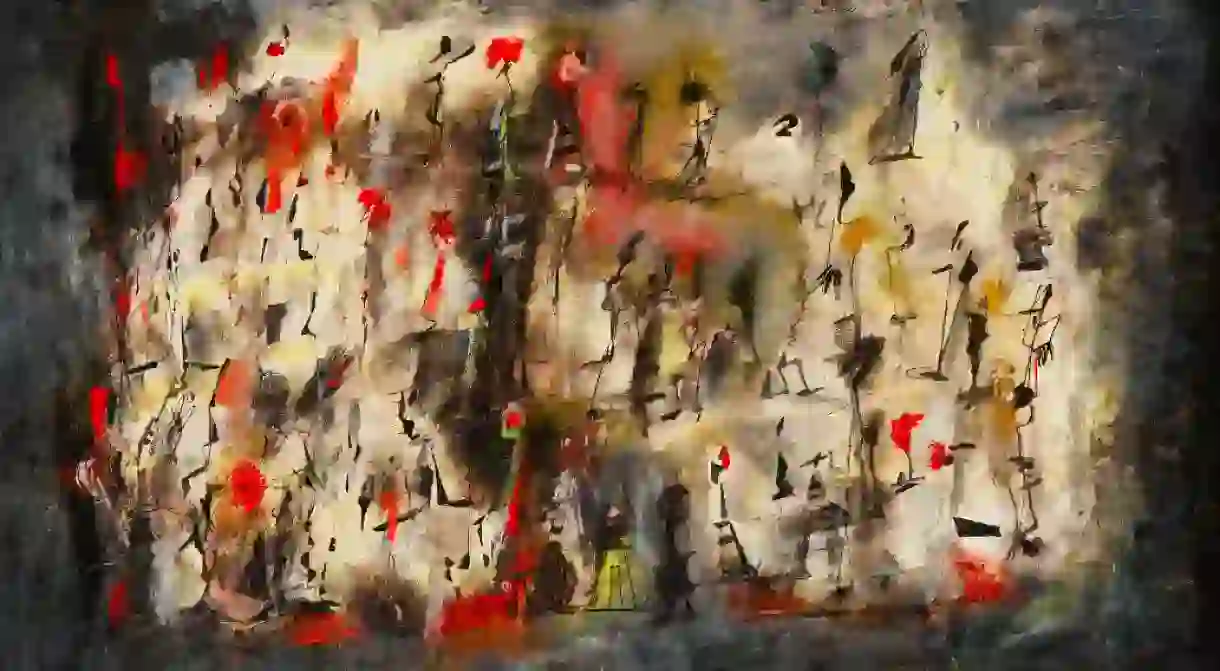The Color Black: Norman Lewis & Abstract Expressionism

Post World War II, a new wave of American art filtered through New York City. Abstract Expressionism – shapes, lines, and non-objective styles – became an influential movement that helped put NYC at the center of the western art world. Born and raised in Harlem, Norman Lewis was one of the few black Abstract Expressionists. His work, which depicts African-American life, urban living, and his community’s struggles, is characterized by both abstraction and representation, without straying too far into the world of the subjective. Lewis’s work is often overlooked, but there has been a revival of interest in his collections since the 1990s.
Norman Lewis developed an interest in art at a very young age. Growing up in a neighborhood with very few African-American families, he quickly became aware of the racial inequalities that plagued the present-day political and social landscape of America. By the age of nine, Lewis already knew he wanted to be an artist, opting to study drawing and commercial design when he reached high school. At the age of 20, he traveled as a worker on an overseas freighter throughout the Caribbean and South America, finally returning to New York a few years later to continue his studies and pursue his interest in art.

Lewis, inspired by the teachings of philosopher and founder of the New Negro Movement, Alain Locke, became interested in African and African-American art. He visited museums and exhibitions and frequented the Studio of Arts and Crafts – a center for black artists founded by African-American artist and educator, Augusta Savage. Here, he learned to use a lithographic press and worked alongside many other important artists, such as Charles Alston and Ernest Crichlow. Savage encouraged Lewis to pursue a career in art, offering him an open studio at the Harlem Community Arts Center.

During the 1930s, Lewis started teaching at the Harlem Community Arts Center. He also worked for the WPA, teaching alongside notable artists, including Jackson Pollock – who later became one of the leaders of the New York School of Abstract Expressionism. In 1934, Lewis joined the Harlem 306 Group, a group of important African-American artists and scholars, and was also active in the Artists’ Union and John Reed Club. After the WPA ended in 1936, Lewis moved his teaching to George Washington Carver School, the home to prominent artists such as Charles White and Elizabeth Catlett. Lewis also taught at the Harlem Youth in Action, an anti-poverty program designed to help keep kids in school, and in 1963, founded SPIRAL – a group of African-American artists who fought for civil rights through art. With the help of other artists, Lewis helped to establish the Harlem Artists Guild and the Cinque for African American Artists, a gallery that showcased the work of African-American artists and helped to foster their careers.

From the 1930s to mid-1940s, Lewis focused on the natural world and personal observations of ordinary people and urban life in Harlem. He painted in the style of Social Realism – a form of art that focuses on naturalistic realism to portray social issues and everyday hardships – but later found that it wasn’t useful in fighting the racism of his time. He turned to abstraction, experimenting with geometric shapes, layering colors, and calligraphic lines meant to represent groups of people. Lewis found himself on the path to self-discovery, many of his paintings expressing vivid social commentary about the struggles of his community and pressing issues of the current Civil Rights Movement. He became known for his use of the color black – a technique that predates that of fellow artist and friend Ad Reinhardt – and later produced a number of etchings alongside paintings that showcased his love for nature.




In 1949, Lewis had his first solo exhibition at Willard Gallery, which featured his famous calligraphic drawings; this New York gallery would host a total of nine shows over the next decade. Just a year later, he was the only African-American exhibitor at prestigious Studio 35 and was featured in MoMA’s Abstract Painting and Sculpture in America. In 1955, he received the Carnegie International Award for Migrating Birds, and the next year, he was invited to exhibit at a show that would represent the US at the Venice Biennale of 1956. Because of his race, Lewis constantly found himself divided between the elite of the art world and his community in Harlem. Despite his involvement with the inner circle of abstract artists, he mostly flew under the radar until the end of his career. He was awarded an NEA grant, a Mark Rothko Fellowship, and a Guggenheim Fellowship in the 1970s, and his first retrospective in 1976. Lewis died unexpectedly in New York in 1979.



Lewis’s oeuvre demonstrates his ability to move freely between various styles of art. His work, while abstract, is never without a narrative. Shapes, lines, and vibrant colors form a subject, together representing a certain thought or idea of his. During a time when racial inequality was at the forefront, Lewis struggled to make a living on his art and has revealed that art institutions during his time only furthered the racist prejudices so widely apparent in the US. Lewis is still overlooked at times, but with a recent renaissance of interest in his works, he has been brought back to life. An exhibit is currently on display at the Chicago Cultural Center until January 8, 2017. Procession: The Art of Norman Lewis demonstrates the lengthy path Lewis traveled down and his influence on art nearly three decades later.















